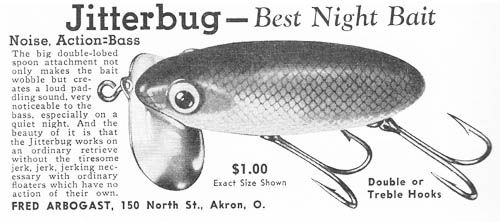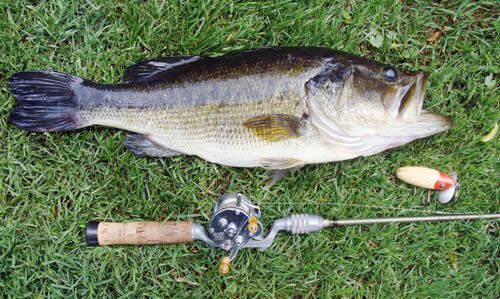The Arbogast Jitterbug and Night Fishing
As a small child the first plug I can remember seeing was a black Jitterbug that my father was casting from shore in the evening at my grandfathers summer cottage in Ohio. As near as I can figure that was the Summer of 1948 or 1949. I was struck by the beauty of the lure and its large eyes. I was also thrilled later that night when he had me come down to the dock and see the two Bass he had caught. He was not a fisherman and cannot recall him ever fishing off our dock again.
I think that evening is when I was first hooked on the idea that Bass fishing was for me. These days I fish several nights a week during the summer and the Jitterbug is one of four or five baits that are regulars for me after dark. Years ago articles about fishing for Largemouths after dark regularly appeared in "Outdoor" magazines. As a young man I read them all and always had high hopes when I attempted night casting, but I seemed to get disoriented on the water and run out of patience. The person who taught me to enjoy night fishing is Herb Larsh of Lansing Michigan. Herb is the best night fisherman I've ever met. I have known him to go out on a lake in the early evening and come off at 9 o'clock the next morning. On more than one occasion I have had to ask him to pull over to shore at 3:30 am and let me out of the boat as my posterior just couldn't take it any more. Herb has passed knowledge on to me (born of his experience) that makes night bass fishing a lot more predictable.
The past 15 years I have read everything I can find on night fishing for bass. It is no accident that almost all of these articles are in magazines and books written before 1960. I recently watched a Saturday morning Bass fishing show starring one of the well known tournament fishing champions. It was suppose to be a "night fishing show," and was being presented in answer to many requests he had received from viewers for such a program. It quickly became obvious that he was not a night fisherman and the poor results were predictable. They don't hold tournaments in the dark for good reasons. They can't be filmed and they don't draw much of a crowd for the weigh-in at 3am.

The earliest known ad for the Jitterbug appeared in the January 1939 issue of Field & Stream. The ad shown above is from the July 1939 issue of Field & Stream. 1939 “outdoor magazines” featured a series of these small, black & white ads for the “New Jitterbug” yet the same issues contained full page ads (many in full color) for Fred Arbogast's other baits such as the Hawaiian Wigglers. By the end of 1939 I believe the Arbogast folks realized they had a very popular bait on their hands, and Jitterbug ads started to show up as full page color ads. The 1939 Arbogast catalog had relegated the Jitterbug to the last page and in black and white. The following year the 1940 Arbogast catalog featured the following great full page color plate of Jitterbugs:

For those interested in the chronology of early wood Jitterbugs, the introduction of various sizes, hardware and box changes, I strongly suggest you get a copy of the November 1998 issue of the NFLCC Magazine where you will fine the most complete article to date on wood Jitterbugs. It was written by my long-time fishing apprentice Warren Platt. Warren is not a night fisherman, but he will tell you the biggest bass he's caught in Michigan is one he landed on a yellow wooden Jitterbug on a coal black night as I rowed him back to the shore at quitting time.
As far as those night fishing lessons I received from the Herb ........
1. Know the lake and its features, don't try to fish a strange lake after dark.
2. Be very very quiet and don't shine any lights on the water.
3. The hotter the weather and the darker the night the better the fishing.
4. Big bass are NOT in the same places they are in the daytime. On a dark night they feed in shallow water (sometimes extremely shallow) with few weeds or obstructions. This is where they can easily chase down prey under the relative safety of darkness.
5. Break out the surface baits and hang on!
I would add, be prepared for strange noises and sights. A couple of years ago I had a Great Horned Owl attack my Jitterbug next to the boat on a pitch black night. It took me a few minutes to get back to fishing after that one.
Another of my favorite ways to employ a Jitterbug is to nurse one through some lilypads on a sunny day. Almost all of my Jitterbugs have upturned double hooks to facilitate this. The following picture is a five pounder taken last Memorial Day at 1:30 in the afternoon on a wood Jitterbug fished in heavy pads. Yes, he was released.

Good Luck!
-- Wild Bill Sonnett
1 comment:
GREAT article on a classic lure. Really makes me want to pull one out of my tackle box and take it fishing tonight!
Post a Comment